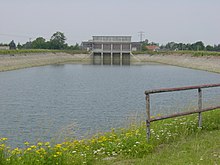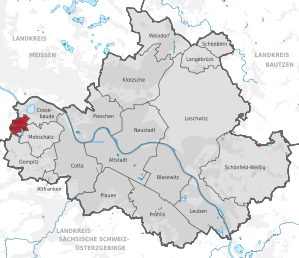Oberwartha
|
Oberwartha locality of Dresden |
|||
|---|---|---|---|
| Coordinates | 51 ° 4 '40 " N , 13 ° 36' 10" E | ||
| height | 240 m above sea level NN | ||
| surface | 2.03 km² | ||
| Residents | 432 (Dec. 31, 2017) | ||
| Population density | 213 inhabitants / km² | ||
| Incorporation | Jan. 1, 1994 ( Cossebaude ) | ||
| Post Code | 01156 | ||
| prefix | 0351 | ||
| politics | |||
| Mayor | Jens Kleinschmidt | ||
| Allocation of seats (local council) | |||
|
|||
Oberwartha is a town of Dresden and is part of the statistical district Cossebaude / Mobschatz / Oberwartha . Oberwartha has about 400 inhabitants and a total area of 203 ha.
history

Oberwartha was first mentioned in a document as Wartha in 1266, the place name has the same origin as that of the neighboring Niederwartha . At that time it was in the possession of the Bishop of Meissen , who had an allodium here. He was also the founder of viticulture around Cossebaude . In 1354 the place is mentioned as Bischoffswartha , in 1495 as Überwart and finally in 1539 as Oberwart . The settlement initially took place around the monastery property. It was not until 1501 that the parcels around Oberwartha were divided up among the villagers, while the place was administered by the Meissen Abbey . In 1708 a windmill, which no longer exists today, was built in the village.
The monastery property , after the Reformation, a manor , changed hands several times and belonged to various middle-class families from the 19th century. One of these citizens was the Dresden merchant Fritz Arndt, who campaigned for the development of the place. Arndt organized the construction of villas to attract wealthy families to Oberwartha. The first villa colony was built on the slopes of the Elbe around 1900. In 1907 a Kurhaus was built, which King Friedrich August III. visited. To improve the development of the place, the construction of a rack railway between Oberwartha and the Elbe valley was planned around 1912 . However, this was not built due to the First World War .

In 1928 the construction of the upper reservoir for the new Niederwartha pumped storage plant began near the village , flooding the Silbergrund.
In the 20s and 30s, further housing estates were built in Oberwartha. The former monastery property existed until 1945 and was then expropriated as part of the land reform . Like the other cultural monuments of the village, it is included in the list of cultural monuments in Oberwartha . At the beginning of 1994 Oberwartha became a district of Cossebaude and was incorporated into Dresden on July 1, 1997.
Development of the population
|
|
literature
- Hans Fischer u. a .: 750 years of Oberwartha 1266–2016. Dresden 2016
Web links
- Oberwartha.de
- Oberwartha in the Digital Historical Directory of Saxony




